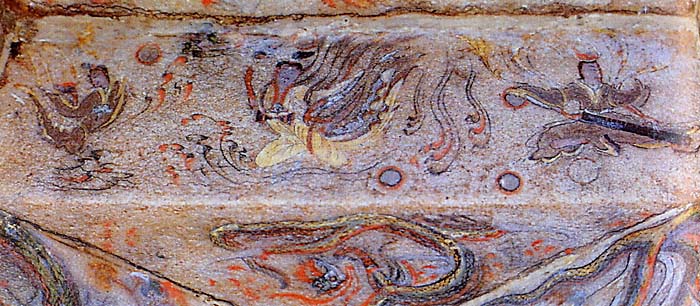
Source: Park, fig. 12, p. 34
The Big Dipper Constellation
Ohoe Tomb #4, 6th - 7th century
Ji'an, China

Source: Park, fig. 12, p. 34 |
The Big Dipper ConstellationOhoe Tomb #4, 6th - 7th century
|
Flying celestial musicians - in India they would be called gandharvas - are playing their instruments as if to welcome the deceased into a pleasant afterlife. The figure in the middle is playing an hourglass-shaped drum that is seen so often in paintings, reliefs, and sculptures from India to Tang China and all along the Silk Road. He is flanked by a musician on the viewer's right who is playing a zither; the figure on the left is a servitor. The bottom of the beam is occupied by a dragon, one of the many who are ubiquitous in this tomb.
There is more going on here, however. The circles represent stars, and this is simultaneously a painting of the Big Dipper constellation (Park, op. cit.). Stylistically this is an example of triadic composition, in which an important central figure is flanked by two less important side figures. Triadic composition is a prominent feature of the Goguryeo tombs, as can be seen in all of the other examples that we have illustrated in these pages. It is also the primary mode of composition of Buddhist sculptures, that feature a Buddha in the middle who is flanked by Bodhisattvas on either side.

|

|

|